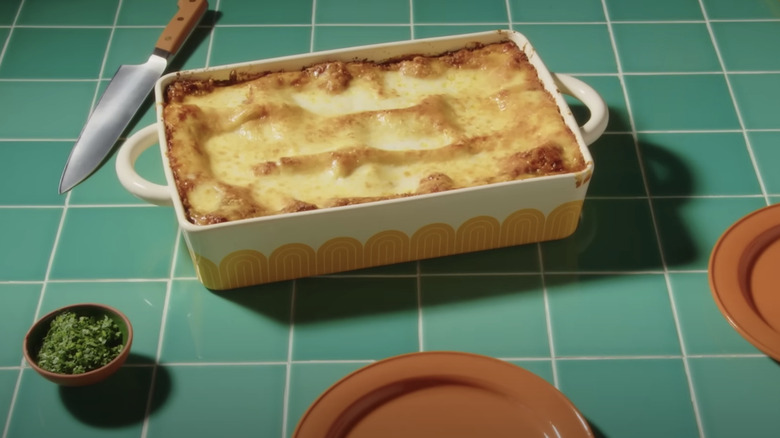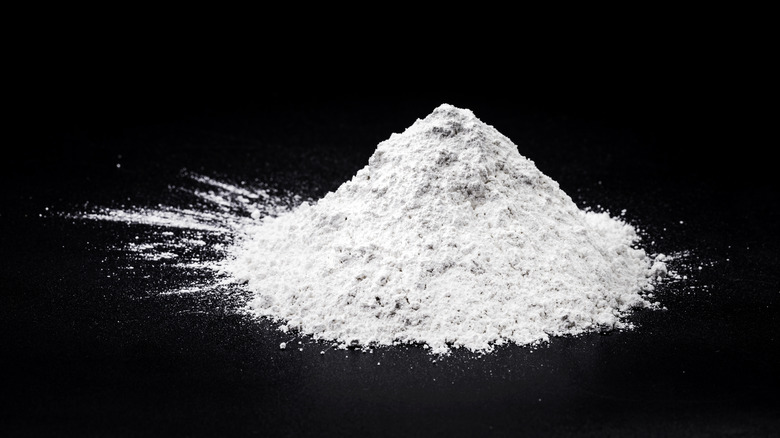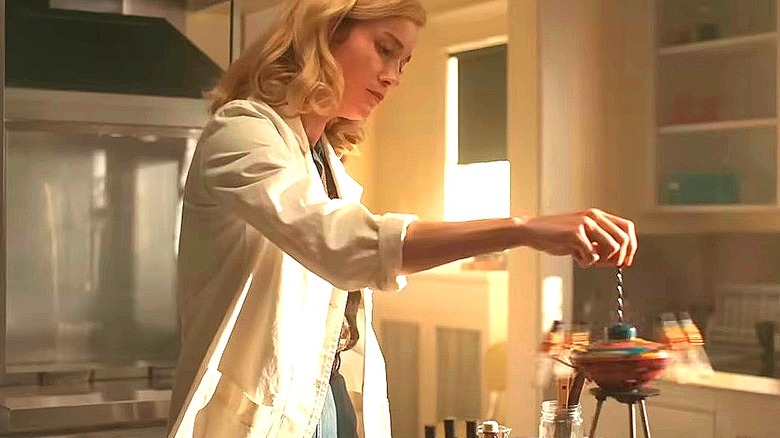Lessons In Chemistry's Lasagna Relies On A Unique Baking Ingredient
You could say it all started with the lasagna. On Apple TV+'s "Lessons in Chemistry" series, two brilliant chemists — both social misfits in their own endearing ways — begrudgingly develop professional respect for one another based on a collaborative project that mere mortals would never understand. But, when leading character Elizabeth Zott offers her counterpart scientist/chemist Calvin Evans a bite of her homemade lasagna, everything changes.
The show, which revolves around a female scientist in the 1950s and 60s who becomes a cooking show host, is an intriguing mix of love, mid-century mindsets, and brainiac intelligence, all delivered through a unique perspective on food. Elizabeth, played by Brie Larson, makes no bones about her primary passion being chemistry. But she applies the same formulaic approach to cooking as she does to chemistry while also pursuing a prestigious grant with her famous lab partner, played by actor Lewis Pullman.
Calvin's incredulous reaction at his first taste of chemistry-via-lasagna is a pivotal point in the show, and in the character's lives, basically personifying the phrase "love at first bite." As Larson told People in a real-life on-air recreation of the magic lasagna, it was the beginning of the real Elizabeth and Calvin relationship.
So, what could possibly make a lasagna so good as to instigate changes in lives, passions, pursuits, and perspectives? Believe it or not, it's a simple ingredient, according to character Elizabeth Zott: sodium citrate, which impacts the cheese and how it melts.
What cooking with sodium citrate does to lasagna
Sodium citrate rarely crops up in standard recipes, but it still has a following, particularly amongst professional chefs. It's not that difficult to purchase, with availability at many online retailers and in smaller specialty shops, and it's simple to use. There's a reason why you may want to give it a try in creating that elusive perfect lasagna.
Unless your recipe calls for processed cheeses made to melt gracefully, you know the disappointment when heated cheese becomes globby and unappetizing. The scientific reason, according to the "Lessons in Chemistry" character Elizabeth Zott, centers around the solid milk fat and the cheese that will liquify at roughly 92 degrees Fahrenheit. That breaks down the casein proteins, but they don't melt smoothly or evenly. That's where sodium citrate comes in. If you add it to the cheese, those proteins separate from one another and act as emulsifiers.
In plain English, that means that food-grade sodium citrate, which is derived from citric acid, helps the cheese remain smooth and creamy when melted. If you've ever eaten Velveeta or American cheese squares, you've likely already seen the effects of sodium nitrate. But you can add it to many of your other favorite cheeses, including those used in lasagna recipes, which typically call for a combination of mozzarella, ricotta, provolone, and sometimes Parmesan. Though sodium citrate is commercially available these days, it's also possible to make some in your own home-kitchen lab using baking soda and lemon juice or citric acid.
The potential for lasagna to be perfect
Cooking is not always about perfection. As Elizabeth Zott tells Calvin Evans in their famous lasagna discussion, using her endearing matter-of-fact monotone voice: "It's not perfect, but it has the potential to be." On the "Lessons With Chemistry" recipe site, the character also states that cooking is chemistry, so anyone who experiments in a kitchen is undoubtedly a chemist.
She also notes that preparing good food is more than a hobby, calling it community, family, and an essential part of life. One dish that embodies that truth, per Elizabeth, is lasagna, and it started with scientific experimentation using sodium citrate.
Lasagna embodies layers and layers, each deliciously different and carefully constructed, to make the "perfect" masterpiece. Actress Brie Larson, during the real-life cooking demonstration for People, explains that her character Elizabeth sees cooking as a metaphor and microcosm for the overall relationship building between her and fellow chemist Calvin.
Reflected in the show's evolving theme, a bit of chemistry and persistence pays off for any chef. But even then, the fictional Elizabeth, a studious chemist and perfectionist, states it took her 78 trials to achieve lasagna perfection. And when she was first offered a starring role as a television chef, on the fictional show called "Supper at 6:00," her first response was, characteristically, "Are you concussed?"



